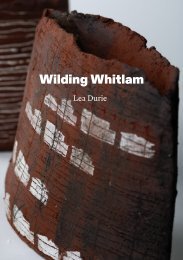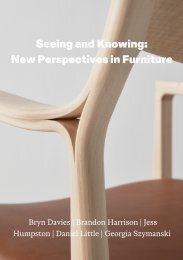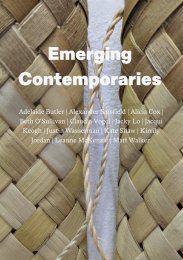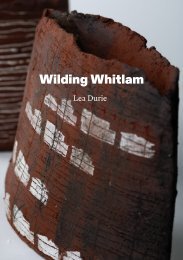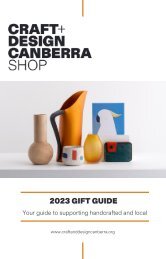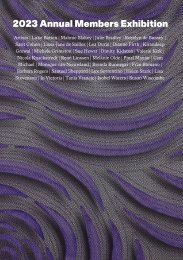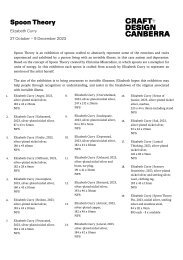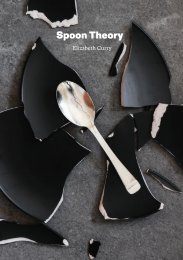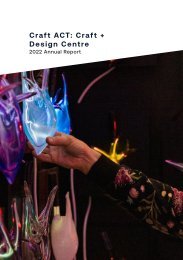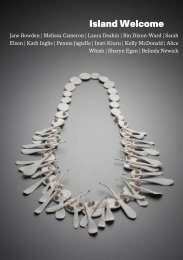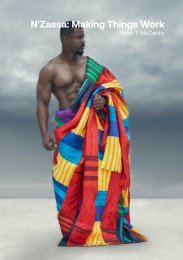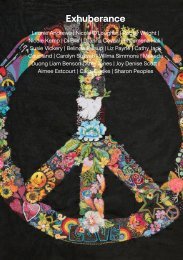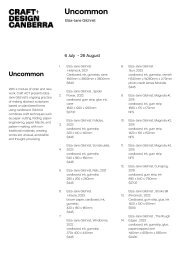Terra Celestial: 2019 artists-in-residence
Terra Celestial: 2019 artist-In-Residence exhibition 26 March - 9 May 2020 Megan Watson | Michelle Hallinan | Sean Booth | Sabine Pagan | Rohan Nicol 2019 Craft ACT artists-in-residence Megan Watson, Michelle Hallinan, Sean Booth, Sabine Pagan and Rohan Nicol present an exhibition of jewellery, objects and paper sculptures. This beautiful new work celebrates the moon landing and was made during a residency at Gudgenby Ready-Cut Cottage in Namadgi National Park and research at Mount Stromlo Observatory. The Craft ACT artist-in-residence program facilitates access for the artist to national cultural, tertiary and research institutions and their collections, curators and researchers. A group exhibition of new work by each artist is held annually, and a catalogue produced. Presented in partnership with ACT Parks and Conservation Service and Mount Stromlo Observatory.
Terra Celestial: 2019 artist-In-Residence exhibition
26 March - 9 May 2020
Megan Watson | Michelle Hallinan | Sean Booth | Sabine Pagan | Rohan Nicol
2019 Craft ACT artists-in-residence Megan Watson, Michelle Hallinan, Sean Booth, Sabine Pagan and Rohan Nicol present an exhibition of jewellery, objects and paper sculptures. This beautiful new work celebrates the moon landing and was made during a residency at Gudgenby Ready-Cut Cottage in Namadgi National Park and research at Mount Stromlo Observatory.
The Craft ACT artist-in-residence program facilitates access for the artist to national cultural, tertiary and research institutions and their collections, curators and researchers. A group exhibition of new work by each artist is held annually, and a catalogue produced.
Presented in partnership with ACT Parks and Conservation Service and Mount Stromlo Observatory.
You also want an ePaper? Increase the reach of your titles
YUMPU automatically turns print PDFs into web optimized ePapers that Google loves.
CRAFT ACT: CRAFT + DESIGN CENTRE
TERRA CELESTIAL
Artists-in-residence
2019
SEAN BOOTH, MICHELLE HALLINAN, MEGAN WATSON, ROHAN NICOL AND SABINE PAGAN
2019 ARTISTS-IN-RESIDENCE
Sean Booth
Michelle Hallinan
Megan Watson
Rohan Nicol
Sabine Pagan
LOCATIONS
Gudgenby Ready-Cut Cottage, Namadgi
National Park, Australian Capital Territory
Mount Stromlo Observatory
RESIDENCY PARTNER (SINCE 2006)
ACT Parks and Conservation Service
Brett McNamara and Mel Barton + team
2019 RESEARCH PARTNER
ANU Research School of Astronomy and
Astrophysics (RSAA)
Brad Tucker
CRAFT ACT RESIDENCY TEAM
Rachael Coghlan (CEO + Artistic Director)
Kate Nixon (Program Director)
Madisyn Zabel (Gallery Manager)
Meagan Jones (Communications + Membership
Coordinator)
PUBLIC PROGRAM
Gudgenby Ready-Cut Cottage open day
13 April 2019
EXHIBITION
Terra Celestial
Craft ACT: Craft + Design Centre
26 March–9 May 2020
Craft ACT: Craft + Design Centre acknowledges the
Ngunnawal people as the traditional custodians
of the ACT and surrounding areas. We honour
and respect their ongoing cultural and spiritual
connections to this country and the contribution
they make to the life of this city and region. We
also acknowledge other Aboriginal and Torres
Strait Islander peoples that have made Canberra
their home and we aim to respect cultural heritage,
customs and beliefs of all Indigenous peoples.
Craft ACT: Craft + Design Centre
Level 1 North Building
180 London Circuit, Canberra
www.craftact.org.au
T (02) 6262 9333
Craft ACT shop + gallery hours
Tuesday to Friday 10am–5pm
Saturday 12–4 pm
Publisher: Craft ACT: Craft + Design Centre
Graphic Design Template: Amy Cox
Typesetting: Storm Design Agency
Printing: Brindabella Print
ABN: 33 314 092 587
© Craft ACT: Craft + Design Centre 2020
Cover Image: Namadgi National Park, 2019.
Photo: Megan Watson
Page 4-5: Mount Stromlo Observatory.
Photo: 5 Foot Photography
2
CONTENTS
INTRODUCTION: THE VALUE OF NATURE AND ART
Rachael Coghlan, CEO + Artistic Director, Craft ACT: Craft + Design Centre
6-9
A FOOTPRINT IN TIME
Brett McNamara, Manager, Namadgi National Park, ACT Parks and
Conservation Service
12-13
TELLING THE UNTOLD OF THE APOLLO 11 MOON LANDING
Dr Brad Tucker, Research School of Astronomy & Astrophysics,
ANU College of Science
14-15
ESSAY: FROM THE ASHES
Rosalind Moran, author
18-21
ARTISTS’ REFLECTIVE ESSAYS
Sean Booth
Michelle Hallinan and Megan Watson
Rohan Nicol and Sabine Pagan
22-33
ARTISTS: STATEMENTS AND BIOGRAPHIES
36-41
ACKNOWLEDGMENTS
45
3
4
5
6
INTRODUCTION: THE VALUE OF NATURE AND ART
Dr Rachael Coghlan, CEO + Artistic Director,
Craft ACT: Craft + Design Centre
How do you quantify the value of an enduring
partnership that creates opportunities for artists and
builds understanding of the extraordinary beauty and
significance of our surrounding environment? One
that unites colleagues from different backgrounds
and disciplines as friends and imagines opportunities
well beyond the project’s original vision.
Those of us who have been fortunate to visit Ready-
Cut Cottage in the remote Gudgenby Valley, or have
observed its profound impact on an artist’s practice,
know very well the value of the annual Craft ACT
/ ACT Parks and Conservation Service residency.
But this residency, which achieves so much with so
little, will need to demonstrate its value to secure
its future beyond the current tight-knit team of
individuals who value and cherish it.
Craft ACT’s small but hugely significant partnership
— to which ACT Parks and Conservation Service
contributes $5,000 each year as well as giving inkind
access to the national park, rangers and the
cottage — results in an annual artist residency that
brings new perspectives and new understandings
to this extraordinary landscape. It also forges
relationships, and a shared commitment to protect
the 106,095-hectare national park, which defines our
region. Every year we receive applications from more
artists than we can accommodate in the residency.
exhibitions, open days and artist demonstrations
since 2006, or one of the 27 artists who have stayed
in the cottage to reflect on their practice and create
new work. Eight research partners have supported
the residency over the years, building understanding
of significant collections from living specimens
to significant archives. The work of writers and
photographers has been featured throughout the
annual catalogues. Many dedicated Craft ACT staff
members have helped to guide participating artists or
install and present their work in an exhibition, and
numerous rangers have shared their extraordinary
knowledge and infectious enthusiasm with the
broader community.
Until 2016, artsACT contributed $10,000 each year
to support international artists to participate in
the residency and build relationships and establish
collaborations with Canberra-region artists. The
residency’s international dimension was lost when
that government funding became unavailable.
But we have soldiered on because this project
matters. It nurtures a deeper connection to our
surrounding environment, Indigenous culture and
knowledge, and sustains a vibrant contemporary
craft and independent studio practice in Canberra.
ArtsACT has listened with respect and attention to
Craft ACT’s advocacy for the reinstatement of this
valuable funding.
The artist-in-residence program has achieved so
much, for so many people. Whether you are one
of the thousands of people who have attended
Opposite page: Open day at Ready-Cut Cottage, Namadgi
National Park. Photo: 5 Foot Photography
7
The recent and devastating fires in Namadgi National
Park made clear the inextricable link between
Craft ACT and our partners at ACT Parks and
Conservation Service. We worried for the safety
and health of our colleagues in the Service as they
fought the fires for weeks on end. We admired their
expertise and energy when they anticipated the risks
to wildlife and buildings and made arrangements to
transfer or protect these assets before the fires hit.
We became emotional when we observed the toll
taken on Brett McNamara and his team from yet
another devastating bushfire engulfing the national
park, so soon after the 2003 bushfires, which
originally inspired the artist residency.
I am grateful to those who made the 2019 residency
such a success — the artists Sean Booth, Michelle
Hallinan, Rohan Nicol, Sabine Pagan and Megan
Watson, and our research partner the Research
School of Astronomy & Astrophysics at the
ANU. It is an honour to express my thanks to
our collaborators at ACT Parks and Conservation
Service, Brett McNamara, Mel Barton and team,
and the awesome Craft ACT team whose personal
determination to sustain this vital program for our
members ensures that a high-quality catalogue,
exhibition, residency and open day is delivered
annually.
Eighty per cent of the national park has been
devastated by fire but, miraculously, the Gudgenby
Valley was protected. It’s now a lush green valley
ready for our 2020 resident artists to experience, to
learn from, and to enjoy space and solitude to build
their craft and design practice. Like the artists who
preceded them, this year’s artists will bring new
perspectives to the valley, which will in turn enrich
and expand ACT Parks and Conservation Service’s
understanding of the landscape. The multiple and
mutual benefits are central to the success of the
artist-in-residence program.
Opposite page: Sean Booth and open day participants at
Ready-Cut Cottage, Namadgi National Park, 2019.
Photo: 5 Foot Photography
8
9
10
11
A FOOTPRINT IN TIME
Brett McNamara, Manager, Namadgi National
Park, ACT Parks & Conservation Service
Residency partner since 2006
Where once a lunar signal was received, there is no
mobile phone coverage today. Instead kangaroos
graze a grassy knoll. Campers gaze upon a night
sky. Pausing, reflecting on a moment that captivated
the world’s attention. A point in time when a man
strolled upon the dusty surface of the moon.
technicians were ready. With Goldstone images
unintelligible, Mission Control soon realised that
Honeysuckle was delivering a superior video feed.
With the flick of a switch, images beamed from the
bush capital allowed the world as one to witness a
truly momentous moment.
Beyond city lights, free from electronic interference,
high on a mountain plateau a signal from the moon
touched down on planet earth. Broadcast to a
worldwide television audience of 600 million people,
Honeysuckle Creek Tracking Station played a pivotal
role in human history.
As the world held its collective breadth, a ghostly
figure climbed down a spacecraft ladder. Hearts raced
as Neil Armstrong took a small step for a man and
a giant leap for mankind. Euphoria erupted. It was a
pinnacle moment.
History tells us that this moment, this journey,
commenced with a bold ambition. In 1962 US
President John F. Kennedy declared that humanity
could choose to go to the moon. Inspiring a nation,
engaging the world, NASA took tentative steps
towards that goal by reaching out to likeminded
countries. In support of the Apollo missions,
tracking stations were established at Fresnedillas
in Spain, Goldstone in California and Honeysuckle
Creek in Namadgi National Park in the Australian
Capital Territory. In 1967 Prime Minister Harold
Holt visited the majestic mountains of the bush
capital to declare Honeysuckle operational. It was a
vital Apollo communication link.
On a cool winter’s morning in July 1969, the Eagle
landed on the moon. With an astronaut’s adrenalin
racing, rest as instructed was not an option. A date
with destiny beckoned. Back on Earth, highly skilled
Those immortal words, those incredible images
captured forever. History was made on that
remarkable day, and Honeysuckle Creek played a
critical role in its making.
Over time, NASA’s intergalactic focus shifted and
the importance of the Honeysuckle site waxed and
waned, subject to enthusiasm for repurposing.
A nature studies site, a youth retreat, even a
correctional institution were all flagged. Eventually
the establishment of a place to retreat from the
grind of daily life prevailed. A picturesque oasis, a
beautiful campground, a place steeped in history. A
place where a small step, leads to a giant connection
with nature.
It was to these mountains that Sean Booth,
Michelle Hallinan, Rohan Nicol, Sabine Pagan and
Megan Watson were drawn and embedded, seeking
artistic inspiration. Their creative responses form
a contemporary narrative underscoring a human
achievement of epic proportion.
Page 10-11: Ben Stevenson, Sean Booth, Sabine Pagan,
Rohan Nicol, Michelle Hallinan, Megan Watson and Craig
Wrainwright at Open Day 2019. Photo: 5 Foot Photography
Opposite page: Ready-Cut Cottage, Namadgi National Park.
Photo: 5 Foot Photography
12
13
14
TELLING THE UNTOLD OF THE APOLLO 11
MOON LANDING
Dr Brad Tucker, Research School of Astronomy &
Astrophysics, ANU College of Science
2019 Research Partner
The 50th anniversary of the moon landing was an
opportunity to celebrate the best in humanity. It was
a chance to celebrate what happens when people
challenge themselves and aspire to be the best. What
was most exciting was the storytelling — telling the
stories of the events, the people, the experiences, the
emotions — the human experience.
In July 2019, we saw and heard the stories of our
friends, neighbours, and Canberrans, and celebrated
the ACT’s contribution to one of humanity’s greatest
achievements. The public wanted to hear and feel
more — what people on Earth and in space saw,
heard, and felt.
Imagine, sitting in a capsule, seeing the moon grow
bigger and bigger. Seeing the Earth grow smaller
and smaller. Landing on the surface — the ground
feels different, smells different. The movements. The
breathing. All, literally, not of this world.
mindset, the thinking, the inspiration. In the truest
sense, they enacted being an artist-in-residence to
celebrate the Apollo 11 moon landing.
The moon is an object in the sky that humans have
observed for hundreds of thousands of years in
wonder and awe, for inspiration, as a form of shared
humanity. The work of the 2019 artists-in-residence
capture these emotions and insights. These are the
views that Megan Watson and Michelle Hallinan
tried to capture.
Every year, the moon is four centimetres further
away from the Earth. A fact that we now know
because Apollo 11 and other missions left reflector
plates on the moon. A fact we know in part because
the Lunar Laser Ranging facility at the Orroral
Observatory in the Namadgi National Park did it.
Being stuck for a week with two other people inside
a capsule the size of a car, drifting away from the
Earth at thousands of kilometres per hour, drifting
away from everything you’ve known. This is what
Sabine Pagan and Rohan Nicol tried to capture: the
Opposite page: Megan Watson at Mount Stromlo
Observatory, 2019. Photo: 5 Foot Photography
Page 16-17: Michelle Hallinan and Megan Watson, As we
were, 2020. Photo: Courtesy of the artists
15
16
17
18
ESSAY: FROM THE ASHES
Rosalind Moran, author
I keep thinking about fragility. As 2019 drew to a
close and smoke lay thick over the Canberra region,
it became clear the decade was retreating not with
a bang, but rather with a muffled cough. A magpie
lay splayed face-down on my driveway like a broken
fan — alive, it turned out, but too exhausted to take
flight in the thick, grainy air. Water helped, though
not enough. The bees vanished and the days went
unaccompanied by birdsong.
Waxing lyrical about nature can feel indulgent, but
it’s striking how urgently one wishes to engage with
the world outside our windows when it seems to be
no longer there.
Although the 2019 Craft ACT artists-in-residence
did much of their work before Australia’s nightmare
summer began, their residencies gain additional
meaning when observed retrospectively. Craft
ACT’s artist-in-residence program is nature-based:
the artists went out into Namadgi National Park to
explore the overlaps of nature with their craft, all the
while staying at Ready-Cut Cottage in the Gudgenby
Valley. The work they produced engages with the
land on which the program took place — Ngunnawal
land — as well as with the 50th anniversary of the
Apollo 11 moon landing, which was one of 2019’s
landmark historical moments. The residencies were
consequently underscored by both global and placebased
history.
anniversary of mankind’s giant leap coincided with
satellite images recording burning rainforests in
Queensland. Programs like Craft ACT’s residencies
offer time and space to artists, helping them to
create — yet at the same time, in some ways, it has
never been as hard to make art as it is now.
Artists, writers, and creative people in general often
discuss the purpose of art, along with the value of
what they do and how their work benefits people,
society, and culture. This conversation might take
place with friends, in an artist statement, or in
writing applications for grant funding. In recent
times, however, questions around the need for and
purpose of art have become newly topical. Scientists
no longer talk just of exploring outer space, but
rather of whether there is any chance of migrating
there, considering the ongoing degradation of our
planet. Terms like ‘climate catastrophe’ have entered
mainstream use. In response, people are asking:
when our way of life feels precarious and the future
is not assured, how do we justify making art?
It’s a troubling question. Making art in times like
these feels fragile. Human industry and human
endeavour, whether in the form of the moon landing
or the commemoration of it, can even feel futile.
The concept of our life’s work potentially being
ephemeral causes real pain to those who wish to
contribute to human knowledge and culture, or who
aim to leave a lasting mark.
The intersection of art, human endeavour, and
nature is complex. For instance, how might these
residencies be viewed through the lens of a firecracked
looking glass? Celebrating the moon landing
takes on a new tone when one realises that the 50th
Opposite page: Sean Booth, Chasing eagles, 2020, silver 925.
Photo: Courtesy of the artist
19
For so many Australians, our recent bushfire season
has made us look with fresh eyes on familiar
environments rendered unfamiliar, and beloved
artistic pursuits rendered more tenuous by the
knowledge they may be forced to take a back seat in
hard times. Where fear and crisis exist, making art —
or even finding the resources to make art — becomes
harder. This is especially true in societies where art
is seen as an optional extra as opposed to essential
to the human experience.
Art is an integral part of being human — and, more
importantly, it is a fundamental part of leading a
fulfilling life. Art isn’t just about material creations,
but also about the mindsets behind these: the
curiosity, the questioning, the exploration. A culture
that values art is also one that encourages debate
and innovation. Among its many possibilities, art
can delight and inspire people; it can comfort; it can
explain difficult concepts; it can imbue the everyday
with the symbolic; it can lend momentum to social
causes, and it can even hold people and power
accountable. It is full of potential, symbolising hope
and investment in the future.
It merits our time, even — and especially — when
we’re not sure how much time we have left.
Despite its myriad possibilities, art can feel
undervalued and vulnerable; sometimes as
threatened as the spaces in which we create it.
Nevertheless, we cannot abandon it. Art that engages
with the past as well as the future — and the land
beneath our feet as well the stars for which we reach
— is art that needs to be made.
Opposite page: 2019 Gudgenby Mission. Soviet munition
Sabine Pagan and Rohan Nicol
Photo: Lee Grant (2020)
Page 22-23: 2019 artists-in-residence, Megan Watson,
Michelle Hallinan, Sean Booth, Sabine Pagan and Rohan
Nicol at Mount Stromlo Observatory, 2019. Photo: 5 Foot
Photography
20
21
22
ARTISTS’ REFLECTIVE ESSAYS
23
24
SPACE FOR THOUGHT: SEAN BOOTH
Dedicated time, removal of diversions and space to
focus can be hard to find in our modern world. With
ever present access to information and distraction
at our fingertips and the feeling that we must be
connected and accessible 12+ hours a day. The
opportunity and location that would allow one to
step away from the electric babble and slip into a
bubble of nature that sits at the doorstep of my
home was a welcome one.
The Australian National University’s Research
School of Astronomy & Astrophysics is, from the
outside, an enigma. Most know what a telescope
looks like but, as you approach the Mount Stromlo
Observatory, you notice that there is only a handful
of structures that look like the classic dome. No
longer primarily a visual observation-focused facility,
scientists associated with the site work remotely,
primarily with data acquired from sites all over the
world. Another aspect that became abundantly clear
was that their concept of time, in which a thousand
years is a mere blip when discussing the millions of
years that have passed when observing light from
deep space, or how long the sun has been burning, or
the time it would take to reach our nearest galaxy.
With my practice often utilising machines, the
chance to see the workshops and the instruments
they produce up close, and the opportunity to
discuss their amazing equipment was a thrill. One
can only imagine what it would have been like to
observe the facilities that once called Stromlo home,
but seeing the small collection of recovered telescope
elements from the devastating fires of 2003 gave
another perspective on the severity of that day.
With the 50th anniversary of the moon landing as a
focal point and the sheer variety of ways that space
can be explored artistically, it was wonderful to be
able to trip deep into Canberra’s bush setting to
reflect. Not needing to steal away moments around
family, work and social commitments to consider the
research material and how to interpret the input. The
welcome isolation found in the Namadgi National
Park gave the space, time and distance to reflect.
I found time was not measured by the tick of the
clock but rather tied to the rhythm and flow of
the day. Responding to light entering in the valley
in which the hut is situated, the daylight hours
influencing your movements and the setting sun
informing you of when to start the fire. The clock
was there but the data it displayed didn’t influence
activity. I was travelling through a landscape that I
had visited 20 years previously during my first year
of university, there was space for thought, memories
and analysis. I returned from the residence with a
headful of thoughts, plans on what I would like to
produce and a realisation that the data on the clock
was once again starting to call the shots.
Opposite page: Sean Booth, Tale of the tape, 2020, fiberglass
ribbon tape, glue, paint. Photo: Courtesy of the artist.
Page 26-27: Sean Booth, Tranquillity, 2020, anodised
aluminium, paint. Photo: Courtesy of the artist.
25
26
27
WAYFINDING: MICHELLE HALLINAN AND MEGAN WATSON
Terra Celestial (earth, sky) was the theme of our
residency at Gudgenby Ready-Cut Cottage, in
Namadgi National Park. ‘Gudge’, as we affectionately
referred to it, became our home for three weeks.
We found a rhythm to our days there, each one
different but familiar. The mornings spent on the
veranda reading, research, contemplation, planning.
The mist rolling through the valley, the roos eating,
sleeping, bounding, and observing us with intrigue
that we reciprocated. As the sun gathered warmth
we gathered ideas and energy, looking to the hills,
valleys and boulders and planning the day’s walk.
We spent many hours tracking our paths around
those valleys, challenging ourselves up over
boulders, taking that next step towards a far off hill,
tree, rock. In the evenings we rugged up and were
energised by clear star-filled nights, photographing
the four points of the night sky, the movement of the
Milky Way and the interplay of starlight reflected off
the Gudgenby River.
Each night the moon, through its different cycles,
illuminated the landscape and our ideas. We sought
to understand the moon through reading personal
accounts of the landing, listening to Apollo 11’s
transmission to the tracking stations, we read
and researched at Mount Stromlo, Tidbinbilla and
immersed ourselves in the historic sites at both
Honeysuckle Creek and Orroral Valley. And yes, we
watched The Dish.
Three themes emerged:
Terra/Earth
Our walks from ‘Gudge’ involved: collecting textures,
patterns and data of tracks traversed. We noted the
topography of the land: granite boulders and hills,
in the form of sketches, photographs and night-light
drawings using LED wands tracing the outline of
the mountains at night whilst moving around ‘moon
rock’ (a large flat moss-covered granite rock near
the cottage, the colour of which would change when
damp or dry).
Data/construction/interpretation
Walking around the remains of Honeysuckle Creek
Tracking Station we contemplated the data collected
on rolls of paper or analogue tape, the transmission
of voice and heartbeat back to Earth, the bulky
computers housed in the site’s office complex. All
that remained was the footprint of the building,
traces of paint and markings where the tracking
station once stood. At Mount Stromlo we saw
laser beams tracking space debris, we observed the
full moon through a telescope, thought about the
first moon landing and how the moon has been
interpreted over the decades. We used GPS to track
our footsteps around the Gudgenby Valley and
considered the interplay of humans with the earth
and the sky.
Moon/celestial
The moon topography: craters, highlands, mountains
as seen through telescopes or with the naked
eye. We looked at the Milky Way and observed
how it traversed the night sky and thought about
Indigenous astronomy, how the Milky Way and stars
were used as navigation and to understand seasonal
changes. Our time was spent looking at the emu
running in the sky.
The residency provided time for contemplation,
discussion of unfolding ideas and the space to begin
to explore, expand and construct our ideas. It was an
invaluable experience allowing time for connection
to land, exploration of wayfinding and contemplation
of time and space.
Opposite page: Michelle Hallinan and Megan Watson,
Remains, terra, celestial (detail), 2020. Photo: Courtesy
of the artists
Page 30-31: Michelle Hallinan and Megan Watson, Reel
book: near real time, 2020. Photo: Courtesy of the artists
28
29
30
31
32
THE 2019 GUDGENBY MISSION: ROHAN NICOL AND SABINE PAGAN
The Ground Crew
Life Aboard
Themed after the 50th anniversary of the Apollo
11 mission, the residency provided us with an
opportunity to use the Ready-Cut Cottage on the
Gudgenby River, deep in Namadgi National Park, as a
SpaceCraft to launch a commemorative re-enactment
of the 1969 moon landing expedition.
Unqualified to fly, we engaged lunar experts Jack
and Jill to undertake the Gudgenby Mission on our
behalf. Known as the ‘Gudgenauts’, we as artists
supported Jack and Jill in their preparation and
journey, together with a team of engineers, scientists
and technicians amongst others.
Closing the Hatch
On launch day, Jack and Jill took the lonely walk
from the Gudgenby parking lot through the
compound gate towards the rear hatch where they
climbed into the repurposed Ready-Cut Cottage,
ready for launch. With the exception of a two-hour
moon walk, the Gudgenauts would not leave their
vessel until Splashdown.
The Launch
Escaping gravity requires extraordinary engineering
and preparation. Like the NASA astronauts 50
years prior, the Gudgenauts undertook rigorous
preparation to ensure they could physically
withstand extreme forces, mentally adjust to
the confines of the SpaceCraft and ultimately be
equipped to handle any unexpected challenges. An
extensive refit of the historic Ready-Cut Cottage
followed by meticulous testing was required to
guarantee it was fit for purpose.
Exiting the Atmosphere
Video footage traced the launch and records the
moment when the Gudgenauts entered the threshold
of space and experienced weightlessness for the first
time.
Routines in space mirror those on Earth. Food,
rest and work provided structure to life on board.
Mission logs show that there is time to pause and
the Gudgenauts did so in the evenings when they
were able to down tools and enjoy weightlessness,
indulge Jack’s penchant for bento, and binge on
downloads from Netflix — because there is no
internet reception out there!
The Moon Walk
After a couple of failed attempts, the Gudgenauts
grounded on an area of the moon suitable for landing
and exploration. Bucket loads of artefacts were
discovered by both Jack and Jill revealing new and
unexpected insights into an unknown history of
moon exploration. Evidence was found of a failed
mission landing, Russian missiles, geological maps
and mysterious plans for a grid-based utopian city.
The Return
The return from the solace of space is difficult. The
Gudgenauts got used to the routine of the mission
and the serenity that comes with being offline. There
is also the risk of burning up should the heatprotective
shield fail on re-entry, elevating tension
on board and in mission control.
Splashdown
Lake Burley Griffin provided a small but viable
landing pad to set down the vessel and re-join the
wider mission team. The vehicle was subsequently
recovered and returned to the shores of the
Gudgenby River where it was decommissioned
and reverted to its former state as the Ready-Cut
Cottage. It can now be accessed via Airbnb, open to
any budding space traveller.
Opposite page: Orbit. Gudgenauts Dog Tag (2019)
Sabine Pagan and Rohan Nicol
Materials: anodised aluminium; cord.
Dimensions: Ø70mm
Photo: Grant Hancock (2020)
33
34
35
SEAN BOOTH
ARTIST BIOGRAPHY & STATEMENT
Sean Booth grew up in the fast-paced city of Sydney,
but has called Canberra home since 1999. Sean
completed his undergraduate studies in 2002 at the
Australian National University School of Art in the
Gold and Silversmithing workshop. In 2003, Sean
established his practice as a metalsmith and he has
maintained a workshop in the region ever since.
His creative direction often looks to push his skills
into new terrain with an attraction to engineering,
manual machining and modern manufacturing
processes. The incorporation of technology and
light has been an undercurrent theme in his
artistic exploration for many years. Balancing this
machine-based approach is a strong knowledge
and application of traditional hammer-forming
techniques, a skill he enjoys employing when the
chance arises.
“Our moon has an enduring influence on our planet,
affecting the environment and fuelling myth and
stories for generations. Linked to this is the desire to
be released from the bounds of Earth, to fly with and
beyond the birds and reach for the heavens themselves.
NASA and those involved utilised language and
iconography to encourage support and tap into myth
and imagination.
Themes that drove my explorations included time,
light and the distance covered to reach the moon.
Outcomes aimed to be playful, while finding ways to
push and expand my skills. The resulting works reflect
on the movement of time, perception of distance and
effect of light.” Sean Booth 2020
Sean has been represented in national and
international exhibitions and has works in national
institutions and private collections. His practice
has continued to evolve and grow with experience
in private commissions, limited-run production,
working to deliver large public art as well as the
passing on of knowledge via teaching. He strives
to balance the desire to create challenging and
complicated works against the knowledge that
simple is not always easy.
Page 34-35: 2019 Gudgenby Mission. Official portrait of
Gudgenauts Jack and Jill
Photo: Lee Grant (2020)
Opposite page: Sean Booth at open day at Ready-Cut
Cottage, 2019. Photo: 5 Foot Photography
36
37
38
MICHELLE HALLINAN AND MEGAN WATSON
ARTIST BIOGRAPHIES & STATEMENTS
Michelle Hallinan engages with the Australian
landscape – micro and macro – to create evocative
works on paper: drawings, prints (etchings/
lithographs) and artists’ books. Recently relocated
to Newcastle, she is exploring her coastal environs
and connection to the natural world. She received
a Masters of Visual Arts (Advanced) from the
Australian National University (ANU) and, in
2016, received a Vice-Chancellor’s Creative Artist
Fellowship Award from the ANU. Michelle has been
in many selected and group exhibitions and has work
in the Art Gallery of New South Wales collection.
“Our work looks at the relationship of the earth to
the sky and how we, as humans, interact with and
interpret that relationship.
The earth is the very foundation from which we derive
and thrive, from terra firma we stand and look to
the sky for guidance, inspiration and information.
We construct interpretations of this relationship
through many channels — books, maps, structures,
innovations, science, data and creative interpretations
in an effort to understand our past, our future and our
place in the world.
Megan Watson is a photographer and filmmaker
working in the Canberra region. Megan’s
photographic work looks at landscapes and the night
sky using natural phenomena to create dramatic
images using a range of methods from long exposure
to image stacking.
Her collaboration with printmaker Michelle
Hallinan, as part of the 2019 Craft ACT Artistin-residence
program, explored opportunities and
techniques to capture celestial bodies, combining
those with landscapes and locations offering a fresh
interpretation of land and sky.
Megan’s film work includes videos that look at
objects, locations and history that give us a sense
of place and identity. Many of these works have
been created in collaboration with local artists and
practitioners. Megan holds a Bachelor in Media
Arts & Production from the University of Canberra
and a Bachelor of Spatial Information Systems from
Charles Sturt University. These degrees combine
Megan’s love of science, technology and art and
have been instrumental in the formation of her art
practice.
Through our residency we devised artworks on these
three levels — we looked at the natural state of the
land, the stars and the sky; we used reflective and
nostalgic interpretations; and collated data, past and
present, to weave into our works.
We focused on threes: Apollo 11 took approximately
three days to reach the moon. There were three
astronauts and three main tracking stations (‘dishes’),
around the world tracking and recording the mission.
Our residency at Ready-Cut Cottage was three weeks
long.
The final outcomes from the residency were three
bodies of work, each with three objects.”
Opposite page: Michelle Hallinan and Megan Watson at
Ready-Cut Cottage, 2019. Photo: Courtesy of the artists.
39
ROHAN NICOL AND SABINE PAGAN
ARTIST BIOGRAPHIES & STATEMENTS
Rohan Nicol is an artist, academic and curator with
interests encompassing studio craft and design. He
holds qualifications from the Australian National
University; the Australian Catholic University; and
Charles Sturt University, where he completed his
PhD. His research and practice link the domestic
with global challenges including material use and
water. Rohan makes things using his craft skills
that prototype new living models, to inspire change
in our habits of consumption in the home. His
strategy is a deft one because it is, in his hands, a
viable proposition not reliant on policy or funding.
His work may be described as a micro-intervention
and its power resides in the fact that his work is —
as a way of thinking – scalable to every home. He
and colleagues have written that if we are to have
any prospect of global renewal, that project will be
contingent on domestic renewal. Rohan has said
that political agency resides in the DNA of craft and
design and that our futures will depend on carefully
crafted ways of thinking and acting. His awards
include the prestigious Bombay Sapphire Design
Award and funding to conduct research from the
Australia Council and Australian universities. His
work is reproduced in books and journals and is held
in collections including the Powerhouse Museum and
the National Gallery of Australia.
Sabine Pagan is an interdisciplinary maker whose
practice spans jewellery, objects and small-scale
installations. Her work is underpinned by a deep
knowledge of materials and processes and their
applications across disciplines. Originally from
Switzerland, where she trained as a jeweller, Pagan’s
professional career in Australia expanded to tertiary
education. She led the Bachelor of Arts Jewellery
program at Charles Sturt University for 10 years
while maintaining an ongoing independent artistic
practice, and later gained a PhD in architecture from
the University of South Australia. Her research on
the significance of sensorial experiences in placemaking
and their influence on memories prompted
interdisciplinary and collaborative projects with
other artists, architects and photographers. Her
current practice is informed by her ongoing interest
in the spatial and sensorial interrelationships
between individuals, objects and places. The act
of making and collaborating form an integral part
of her work, blurring the boundaries between
makers, objects, environments and those who
experience them. Pagan works from her studio
in Queanbeyan, producing works for exhibitions,
client-based commissions and collaborations such
as the Gudgenby Mission project featured in this
exhibition.
“The Apollo 11 moon landing was a remarkable
achievement, shaping global politics and popular
culture. In 2019, the 50th anniversary celebrations
of the mission attracted fevered attention and
unquestioned endorsement of NASA’s 1969
accomplishment. As moon mania swept across our
media and through public events, the anniversary was
used as an opportunity to push for new investment
in space exploration; interestingly, few seemed to
question the deeper ethical questions surrounding
space travel. Considering the relentless drought,
fires, and freak storms that the world is experiencing,
humanity might benefit from focusing attention and
public funds on issues closer to home, that burn less
fuel and address our expanding footprint.
In response to the 50th anniversary of the Apollo
11 mission, we undertook a parallel alter-mission,
transforming the historic Ready-Cut Cottage in
Namadgi National Park into our own SpaceCraft,
piloted by our alter egos, Gudgenauts Jack and
Jill. Over a period of eight days, three hours and
18 minutes — just like the NASA astronauts 50
years prior— Jack and Jill bravely launched, left
this atmosphere, took a moonwalk and came home.
They collected artefacts that, together with carefully
selected mission paraphernalia, are presented to
celebrate, parody and question space travel then and
now.”
Opposite page: 2019 Gudgenby Mission. Looking back at Earth.
Sabine Pagan and Rohan Nicol
Photo: Courtesy of Gudgenby Mission Archive
40
41
42
43
ACKNOWLEDGEMENTS
The 2019 Craft ACT artist-in-residence Program
was hosted in partnership with ACT Parks &
Conservation Service who has supported the
residency since it began in 2006. Our 2019 research
partner was the Research School of Astronomy &
Astrophysics (RSAA), ANU College of Science. We
would like to thank our cherished friends at ACT
Parks & Conservation Service for their ongoing
support, especially Brett McNamara (Manager,
Namadgi National Park) and Mel Barton (Manager,
Visitor Services). Thanks to Brad Tucker (Research
Fellow) at the RSAA for his engagement of the
artists while undertaking the research. Huge thanks
to the participating artists, Sean Booth, Michelle
Hallinan, Megan Watson, Rohan Nicol and Sabine
Pagan for embracing the theme and opportunity.
Sean Booth would like to thank…
NASA for making publicly available a digital 3D
model of the Sea of Tranquillity among other great
resources. The support from my partner, Elizabeth
Vermeesch, and my daughter Jasmine, and support
from Craft ACT and ANU School of Art & Design.
Rohan Nicol and Sabine Pagan would like to
thank…
The team at Craft ACT;
ANU Research School of the Astronomy &
Astrophysics;
ANU School of Art and Design;
ANU Research School of Electrical Energy and
Materials Engineering, in particular Ass.Prof Matt
Doolan and Terence Wiseham.
Special thanks to
Prof. Damian Candusso, Gia Cheng, Lee Grant,
Megan Jackson, Ross Peak, Saskia Scott and the
‘Gudgenby’ staff from the Namadgi National Park
and Visitors Centre.
Michelle Hallinan and Megan Watson would like
to thank…
We couldn’t have done this without the help and
support of some wonderful people, organisations
and businesses: Craft ACT and all its staff, ACT
Parks and Conservation, ANU Research School of
Astronomy & Astrophysics, Fiona Edge, Jeremy
Lepisto, Caren Florance, Emma Beer, Sean Booth,
Craig Wainwright and the staff at Namadgi Visitors
Centre, Brad Tucker and the students who helped
us with the telescope, Plastic Creations (Kirsty in
particular), Lucent Imaging, Acuform, The Laser Co,
our workshop participants.
Page 42-43 & opposite page: Artist-in-residence open day at
Ready-Cut Cottage, 2019. Photos: 5 Foot Photography
Page 46: Artist-in-residence open day at Ready-Cut Cottage,
2019. Photo: 5 Foot Photography
Back cover image: Ready-Cut Cottage, Namadgi National
Park. Photo: 5 Foot Photography
45
Artist-in-residence Open Day, 2019
Photo: 5 Foot Photography
Craft ACT: Craft + Design Centre is supported by the
ACT Government, the Visual Arts and Craft Strategy
- an initiative of the Australian, State and Territory
Governments, and the Australia Council for the Arts - the
Australian Government’s arts funding and advisory body.
Artist-in-Residence Program Partner
Research School of Astronomy & Astrophysics
2019 research partner
Craft ACT is supported by
48




